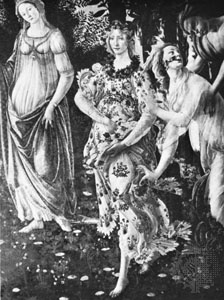drapery
art
 depiction in drawing, painting, and sculpture of the folds of clothing. Techniques of rendering drapery clearly distinguish not only artistic periods and styles but the work of individual artists. The treatment of folds often has little to do with the nature of the actual material; its significance stems largely from the fact that it presents to the spectator the main mass of the clothed human figure.
depiction in drawing, painting, and sculpture of the folds of clothing. Techniques of rendering drapery clearly distinguish not only artistic periods and styles but the work of individual artists. The treatment of folds often has little to do with the nature of the actual material; its significance stems largely from the fact that it presents to the spectator the main mass of the clothed human figure.In classical art the treatment of drapery varied between tightly meticulous and free-flowing lines. In the Hellenistic period the main emphasis was on volume rather than line.
Christian iconographers of the Middle Ages adopted the Classical tradition of drapery and clothed Christ, the Virgin, and the Apostles in vaguely togalike garments, with little relation to historical accuracy. A gentle interplay of soft folds characterized the European Gothic (Gothic art) style from the 13th century onward, and that tradition—modified by Classical influences such as the use of linear patterns—was taken over by artists of the Renaissance who painted diaphanous, figure-revealing garments. Mannerist and Baroque (Baroque period) drapery emphasized the theatrical potentialities of drapery. At the same time, many painters began to employ in their studios specialists to draw and paint dress and drapery.
In the 19th century in France, the lavish dresses of the Second Empire made it inevitable that any painter concerned with contemporary life must pay considerable attention to drapery. With the advent of Art Nouveau this concern became even more emphatic. Also in the 19th century, the growth of popular fashion magazines and of the haute couture stimulated the development of fashion drawing as an art form evolved from drapery drawing.
- Nicomachus of Thebes
- Nicopolis Actia
- Nicopolis, Battle of
- Nicosia
- nicotine
- Nicoya, Gulf of
- Nicoya Peninsula
- Nicéphore Niépce
- Niderviller ware
- Nidularium
- Nidwalden
- Niebuhr, Barthold Georg
- Niebuhr, Carsten
- Niebuhr, Helmut Richard
- Niebuhr, Reinhold
- Niedere Tauern
- Niederösterreich
- Niel, Adolphe
- Niel Gow
- niello
- Niels Bohr
- Nielsen, A.C.
- Nielsen, Alice
- Nielsen, Carl
- Nielsen, Morten